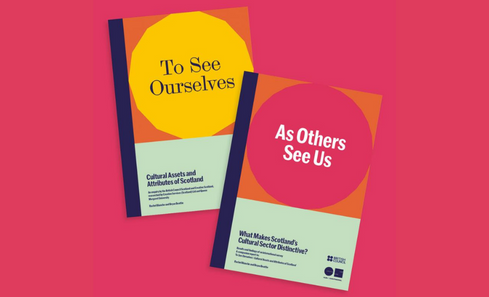Published: 06 Jul 2022
Scotland’s creative sector is world-renowned for its festivals, arts, and culture but what makes it distinct?
British Council Scotland and Creative Scotland launch a new report about Scotland’s creative sector. It provides a snapshot of the sector’s distinctive assets and attributes and reveals the story of Scotland’s cultural standing within the country and on the international stage.

The report, which is the first of its kind, is presented in two sections, To See Ourselves and As Others See Us and involved interviews with strategic leaders across Scotland’s creative industries, as well as surveys with international and Scottish arts professionals.
Alongside looking at Scotland’s intangible and tangible cultural heritage such as its history, landscapes, language, people and stories, those surveyed considered factors such as the impact of Covid-19, Scotland’s complex relationship with England and the authenticity of its cultural heritage.
Internationally, those surveyed perceived Scotland’s cultural assets positively – citing the sector as innovative, vibrant, contemporary, and diverse. This was echoed by those based in Scotland, however they also perceived it as fragile, under-funded and under-resourced.
In terms of values, respondents felt that the sector had a strong social ethos with community and grassroots foundations, with the sector firmly rooted in tradition, honouring Gaelic and traditional arts, while also being forward-looking and forward-thinking.
Arts professionals around the world were impressed by the number and quality of festivals, artists and organisations, especially given Scotland’s size, alongside the sector’s warmth and friendliness and ‘profound professionalism’. Not surprisingly, Scotland’s heritage and history was recognised as unique to Scotland, with the Edinburgh Festival and other festivals viewed as unique elements of its cultural heritage.
Reflecting on the question ‘What are Scotland’s cultural assets?’, the authors gathered views from across the country – using discussion groups, questionnaires and interviews, and built a rich picture of both the opportunities and the challenges experienced by the sector. The authors observe ideas about how the fabric of Scotland is changing, notions of diversity and egalitarianism, and Scotland’s geography and unique sense of place.
In a deep dive into global perceptions, this section presents data on what makes Scotland’s arts and culture sector distinctive on the international stage. The report reveals that Scotland’s cultural policies, arts for children and young people, and the disability arts sector are among key cultural assets as perceived by stakeholders.
Written by Bryan Beattie, Director of Creative Services Scotland and Rachel Blanche, Lecturer in Cultural Policy, Queen Margaret University, the report will serve as a rich resource of first-hand information and model working for the sector to draw upon in its work to recover from the impacts of the global pandemic. As well as a practical tool to inform, it is hoped that the content of the report will inspire new engagement with international stakeholders.
The British Council and Creative Scotland have worked in a strategic partnership for over ten years, identifying and investing in long-term strategy to further international cultural relations and to help create new opportunities globally for the Scottish arts sector. This work has resulted in strong international connections for artists, organisations and projects through programmes such as Momentum, that has brought over 900 delegates to Scotland over the last decade, and for major seasons in India, Brazil and Japan, and events such as the Edinburgh International Festival itself. This report delves into Scotland’s place in the world and shows how these global connections contribute to the unique assets of Scotland’s creative sector.
Speaking about the report, Norah Campbell, Head of Arts, British Council Scotland said;
“Working internationally for the arts & cultural sector in Scotland, it would be easy to take-for-granted the strength of the sector’s international outlook and engagement. It has been fascinating to see this report taking shape and to again insight into the thoughts and reflections of contributors about what makes Scotland’s arts and culture distinct. The pandemic has brought with it many challenges but also a time to reflect, and we hope this report will prove a powerful contribution to the ongoing development of the creative sector and to Scotland’s cultural diplomacy”.
Laura Mackenzie-Stuart, Creative Scotland’s Head of Theatre said;
“As we emerge from the pandemic, picking up with our global counterparts to showcase our arts and cultural assets is more important than ever as part of the recovery for the arts and creative sectors. This report is an important reminder of how strong our global relationships already are and provides valuable insight into what others see in us as distinctive and valuable, ultimately helping us be priority collaborating partners”.
Bryan Beattie, Director of Creative Services Scotland and co-author of the report added;
“We started our research by asking people to describe what they felt was distinctive about Scotland’s cultural sector, and we soon realised that while many respondents had spent a lifetime in the creative industries, few had taken the time to consider this question. When given the chance to discuss with colleagues across the sector, it catalysed a range of views and many found it revealing about their own practice. I hope that people across the creative sector will use the report as a starting point to develop this important conversation”.